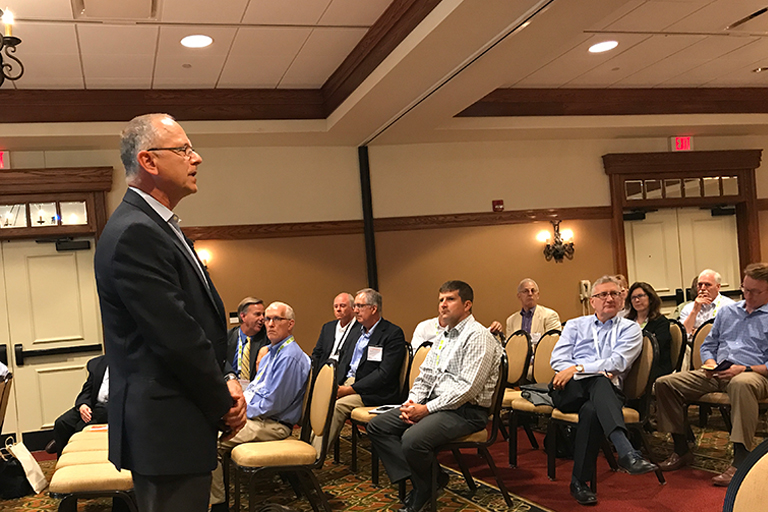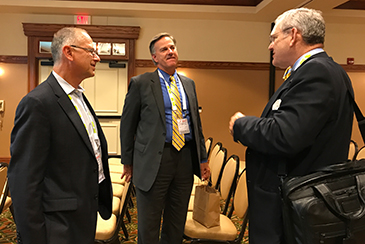
How To Execute An Executive Succession Plan
By joe | June 29, 2017
As many as 50 percent of nonprofit leaders are expected to leave their positions within the next five years. Only one-third of organizations have a succession plan, and even fewer have an executive director transition plan, according to an August 2016 BoardEffect story quoting BoardSource statistics.
In just one nonprofit sector—senior living—approximately 43 percent of the current CEOs already are or will reach age 65 in the next five years, and many COOs and CFOs are just three to five years behind them.
At a recent industry event, Tim Ficker, managing director of MHS Consulting, led a panel entitled, “Ten Things Every Board and CEO Should Do to Prepare for Executive Transitions—and a Few Things NOT to Do!”

Ficker urged the senior living executives to develop proactive rather than reactive succession plans and develop system-wide annual reviews of the bench strengths of their organizations.
“You want to get to where you’re assessing your team once a year,” Ficker said, “and you better be doing leadership training and development, including individual plans. The industry is going to be starving for leaders in the next 5-10 years. The only place they’re going to come from is our communities.”
Ficker offered these tips on succession planning:
Top 10 Things To Do:
- Have the conversation with your CEO or Executive Director before it becomes imperative. It should be an annual conversation, with light-hearted questions at first, the idea being to determine possible plans for retiring.
- Develop an awareness of the executive team and any potential successors. Is there a Succession Plan in place? Is there a board policy regarding executive transition? You should have an idea of who might be qualified. Start a board policy with an emergency plan, then some basic steps.
- Review/revise the job description to reflect the key priorities and “success” measures. It should spell out what success looks like at the end of the first and second year, with three to five success measures a candidate can look at. Who are the top 10 on your team? Study the behavior skill sets of the top two, and that becomes the framework for the new job description. Teams have A players, B players, C players; there’s always going to be a lot of B players. You have to rate your team. When you’re interviewing and share success measures with candidates, A players are energized; B players are wondering if there’s any wiggle room; C players—you’ll never see them again. You need consistency from the job description through the interview. It may be harder in small organizations, but do some benchmarking with other organizations. Identifying the success measures works in any size organization. It’s the most humane way to treat people, rather than making them guess. At the end of the year, evaluate them and reward them.
- Learn about the respected Executive Search firms, the types of searches they offer and the fees they charge. A search can take up to 200 hours with screening calls, rounds of background checks and calls. A C-suite person will probably cost 30 percent of the outgoing executive’s first-year salary for a four- to eight-month search. Since the recession, the first reaction often is to go to the CFO, because it feels safe to have the guy who understands the numbers taking care of the organization. However, the skill sets aren’t necessarily the same. Sometimes we pigeonhole people, and they may not be the best. If you have a legacy CEO, someone with 15 years or more, it’s a traumatic thing to replace that person; it’s not likely the successor will be the same. If you’re on a search committee, what exactly are you looking for? The next five years will be different than the last five to 10 years.
- Discuss and discern desired profile for top candidates.
- Determine best make-up of the Search Committee.
- Conduct a compensation study to determine appropriate and competitive salary, bonus plan and benefits. Many organizations are shocked at what the numbers are if an executive has been in place for a long time. Many salaries are outdated for CEOs in the job 20 years. A lot of candidates are going to have some motivation for a signing bonus, relocation bonus or some kind of bonus structure, even if the salary is less.
- Thoughtfully plan exit strategy and communication strategy to constituents for departing executive. How you communicate with staff, residents and the general community should be well planned.
- Thoughtfully plan on-boarding of new executive, including six-month review. Six months external executive coaching is suggested for the new executive. One new CEO was paid to come a week before he actively started the job, so he could meet the community.
- Consider options for the utilization of an interim executive if needed. An interim is a great way to take the pressure off an executive search. Some retired CEOs are working as interims. Search firms may have a group of executives who will serve as interims. They’re not cheap, but it’s money well spent.
Top 10 Things NOT to Do!
- Do not wait until an announced retirement to begin planning.
- Do not assume there is a succession plan in place.
- Do not assume internal candidates will raise their hands. They expect someone will come to them. Make sure internal folks have a vehicle to raise their hands.
- Do not leave the planning to the outgoing CEO.
- Do not fail to solicit input about profile for next executive from all board members.
- Do not invite outgoing CEO onto the Board for at least two years. Outgoing CEO should overlap new hire no longer than one week. When asked, Ficker said he didn’t have a problem with a person being hired off the board, but the old CEO should get out of the way for at least a year.
- Do not ask the outgoing CEO to design the compensation strategy for his/her successor.
- Do not assume that only experienced CEOs can be viable candidates.
- Do not leave communications to residents/staff/clients solely in the hands of outgoing CEO or HR. Ficker mentioned a company that hired two potential replacements for a CEO retiring the following year and ended up choosing one. They also hired a communications consultant a year ahead to handle the communications process.
- Do not fail to be present at farewell reception for outgoing CEO.




